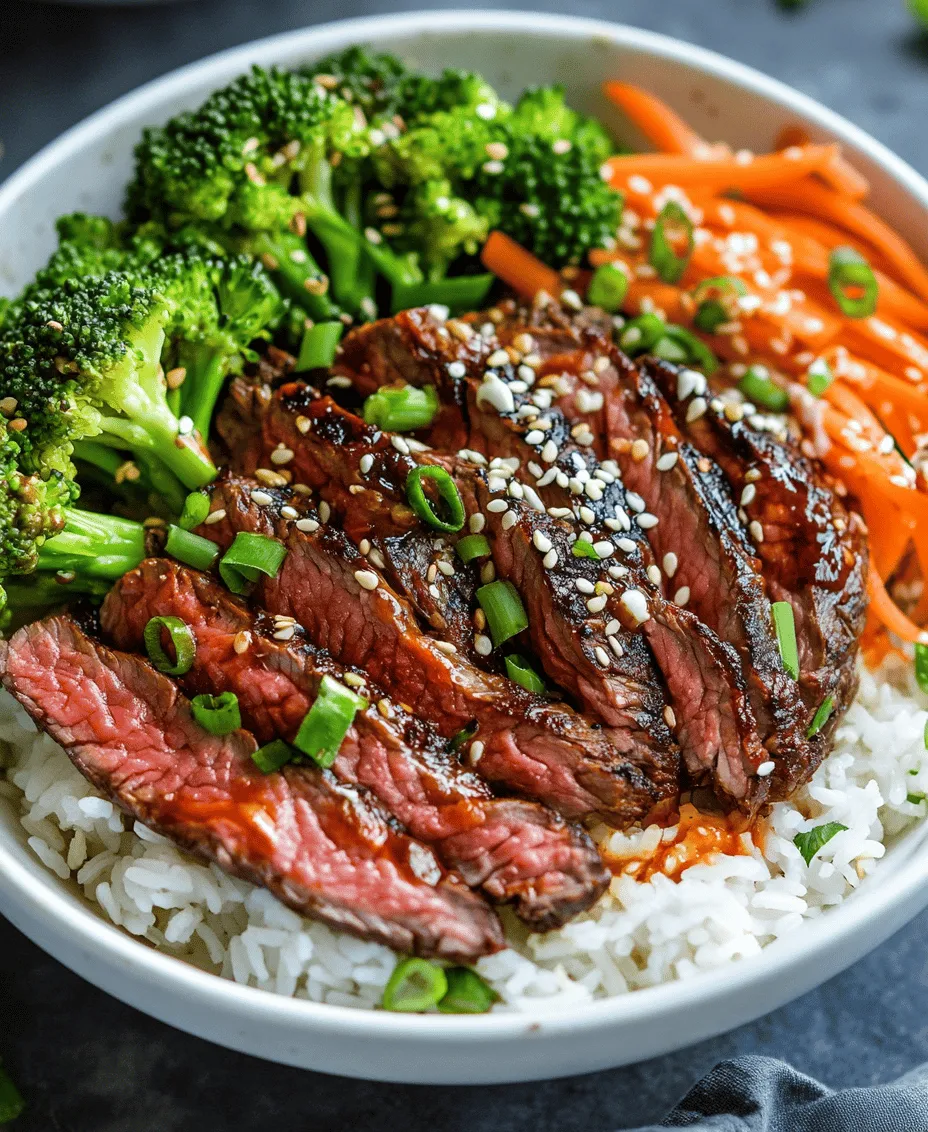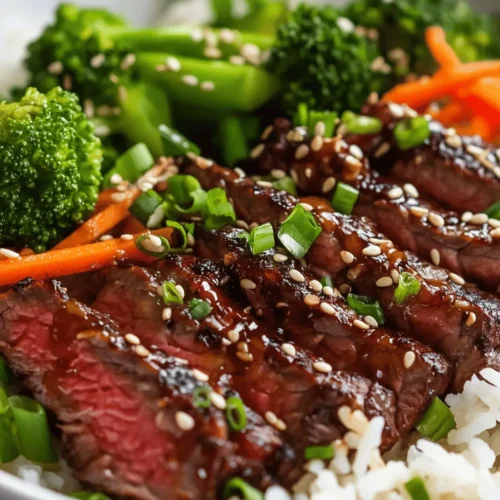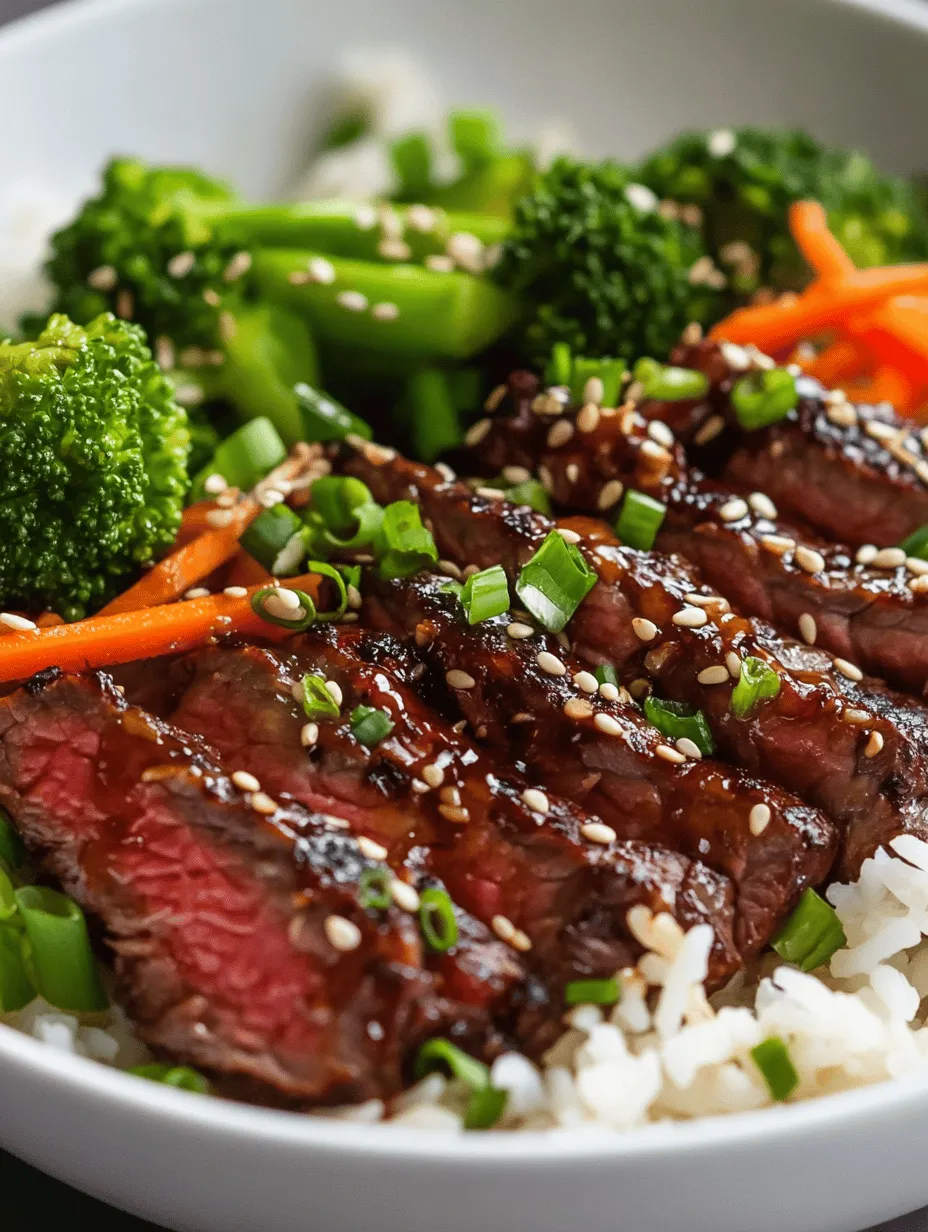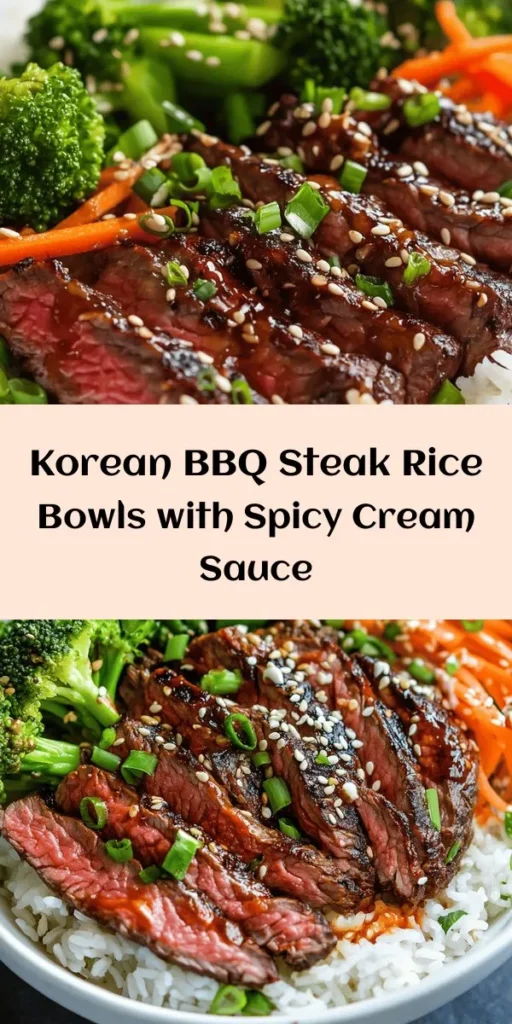In the vibrant world of Korean cuisine, few dishes encapsulate bold flavors and satisfying textures as beautifully as Korean BBQ Steak Rice Bowls with Spicy Cream Sauce. This dish marries tender marinated flank steak with fresh vegetables and fluffy jasmine rice, topped off with a creamy, spicy sauce that elevates each bite. Perfect for a weeknight dinner or a weekend gathering, these rice bowls are not only delicious but also customizable to suit your palate. In this article, we will delve deep into the preparation of this delightful dish, exploring the ingredients, step-by-step instructions, and the cultural significance of the flavors involved.
Understanding Korean BBQ and Its Cultural Significance
To appreciate the Korean BBQ steak rice bowls fully, it’s essential to understand the roots and traditions of Korean BBQ itself. Korean BBQ, or “gogi-gui,” translates to “meat roast” and typically involves grilling marinated meat at the table, creating a lively and interactive dining experience. This method of cooking is not just a meal; it’s a cultural event that fosters community and connection. Families and friends gather around grills, sharing laughter and stories while preparing their food.
The evolution of Korean BBQ in modern cuisine has seen it transcend its cultural boundaries, becoming a popular dining choice worldwide. From bustling Korean BBQ restaurants in urban centers to food trucks offering fusion dishes, Korean BBQ has made a significant mark on the global culinary scene. Its rich flavors and communal dining style have influenced food trends, inspiring chefs to incorporate aspects of Korean BBQ into various dishes and cuisines, leading to an explosion of flavors that can now be found in diverse culinary landscapes.
Notably, Korean BBQ has inspired dishes that are not only enjoyed in restaurants but are also easily replicated at home. The Korean BBQ Steak Rice Bowl is a prime example, allowing anyone to experience the joys of this cuisine in their kitchen.
Ingredient Breakdown
A Detailed Look at the Main Ingredients
When it comes to crafting the perfect Korean BBQ steak rice bowl, choosing the right ingredients is crucial. The key components not only provide flavor but also contribute to the dish’s overall texture and appeal.
– Flank Steak: Choosing the best cut for grilling is essential for a tender and flavorful result. Flank steak is a lean cut that benefits from marination, allowing it to absorb the flavors of the marinade while ensuring it remains juicy when cooked. When selecting flank steak, look for a piece that has a bright red color with minimal visible fat, which will ensure a better grilling experience.
– Soy Sauce and Sesame Oil: These ingredients form the foundation of flavor in many Korean dishes. Soy sauce adds a salty, umami flavor that enhances the meat, while sesame oil brings a nutty richness that complements the other ingredients beautifully. When combined, they create a savory base that penetrates the steak during marination.
– Gochujang: Understanding this essential Korean ingredient is vital for anyone looking to explore authentic Korean flavors. Gochujang is a fermented red chili paste that adds depth and heat to dishes. Its sweet and spicy profile is perfect for marinating meats and creating sauces, making it a staple in Korean kitchens.
– Honey: The sweet balance to spicy flavors, honey is often used in marinades to counteract heat. It caramelizes during cooking, creating a beautiful glaze on the steak that enhances both flavor and appearance.
– Garlic and Ginger: These aromatics enhance the taste of the marinade and the overall dish. Garlic adds its pungent, savory quality, while ginger provides a warming spice that brightens the flavors. Fresh is always best, as it brings a vibrant kick compared to dried versions.
Exploring the Vegetables Used in the Recipe
In addition to the steak and sauce, the vegetables used in Korean BBQ steak rice bowls play a significant role in providing texture and nutritional benefits.
– Broccoli: Known for its nutritional benefits, broccoli is rich in vitamins C and K and adds crunch to the dish. When lightly sautéed, it retains its bright color and nutritional value, making it an excellent accompaniment to the steak.
– Carrots: Adding color and crunch, carrots are not only visually appealing but also contribute natural sweetness to the bowl. They are packed with beta-carotene and provide a satisfying bite when cooked properly.
– Green Onions and Sesame Seeds: The finishing touches of green onions and sesame seeds enhance the dish’s presentation and flavor. Green onions provide a mild onion flavor, while toasted sesame seeds add a nutty crunch that ties the dish together.
Marinade Magic
The importance of marinating steak cannot be overstated. Marination enhances flavor and tenderizes the meat, ensuring a juicy and delicious end product. For flank steak, a recommended marination time is at least 30 minutes, but if time allows, marinating for a few hours or overnight will yield even better results. The longer the steak marinates, the more flavor it absorbs, leading to a more robust taste.
Step-by-Step Guide to Creating the Marinade
Creating the marinade is a simple yet essential step in preparing these Korean BBQ steak rice bowls. Here’s how to do it:
1. Combine Ingredients for a Balanced Flavor Profile: In a mixing bowl, start by whisking together soy sauce, sesame oil, gochujang, honey, minced garlic, and grated ginger. These ingredients work in harmony to create a marinade that is salty, sweet, spicy, and aromatic.
2. Tips for Ensuring Even Coating of the Steak: Once the marinade is well-blended, place the flank steak in a resealable plastic bag or a shallow dish. Pour the marinade over the steak, ensuring it is well-coated. If using a bag, seal it tightly and massage the marinade into the meat for even distribution. If using a dish, cover it with plastic wrap to prevent spills while marinating.
3. Marinating Time: Allow the steak to marinate in the refrigerator for at least 30 minutes. For optimal flavor, marinate for up to 24 hours. This not only infuses the meat with flavors but also tenderizes it, making for a more enjoyable dining experience.
Crafting the Spicy Cream Sauce
No Korean BBQ steak rice bowl would be complete without the spicy cream sauce that adds a rich and zesty kick to the dish. A closer look at the ingredients reveals the harmonious balance of flavors that this sauce brings to the table.
– Mayonnaise as a Base: The creamy texture of mayonnaise serves as the foundation for the sauce, contributing a smooth mouthfeel that contrasts beautifully with the other textures in the bowl. It acts as a canvas, allowing the flavors of the other ingredients to shine through.
– Gochugaru: Adding another layer of heat, gochugaru is the Korean red pepper flakes that provide a smoky, spicy kick to the sauce. It’s less pungent than gochujang and offers a different flavor profile that complements the other elements in the dish.
In this section, we have explored the foundational elements of Korean BBQ Steak Rice Bowls with Spicy Cream Sauce. With its rich flavors and cultural significance, this dish is a celebration of both Korean culinary tradition and modern dining. As we continue, we will delve into the step-by-step instructions for preparing the rice bowls, ensuring that you can recreate this delightful experience in your kitchen.

Balancing Flavors: The Role of Lime Juice and Sesame Oil
Creating a harmonious flavor profile in your Korean BBQ Steak Rice Bowls with Spicy Cream Sauce begins with understanding the role of key ingredients like lime juice and sesame oil. Lime juice adds a refreshing acidity that brightens the dish, balancing the richness of the steak and the creaminess of the sauce. On the other hand, sesame oil contributes a nutty depth that enhances the umami flavors, making every bite irresistible.
Step-by-Step Instructions for Making the Sauce
To achieve the perfect spicy cream sauce, you will want to follow these simple steps:
1. Gather Your Ingredients: You will need mayonnaise, sour cream, sriracha, lime juice, sesame oil, and a pinch of salt.
2. Mix the Base: In a medium-sized bowl, combine ½ cup of mayonnaise and ½ cup of sour cream. This combination provides a creamy texture that serves as the foundation of your sauce.
3. Add the Heat: Stir in 2-4 tablespoons of sriracha, depending on your heat preference. Start with less if you’re unsure, as you can always add more later.
4. Incorporate the Flavor: Add the juice of one lime and 1 tablespoon of sesame oil. These ingredients will transform your sauce, adding both acidity and depth.
5. Season to Taste: Finally, sprinkle in a pinch of salt to enhance the flavors. Mix the sauce well until it reaches a smooth, consistent texture.
6. Adjust Consistency: If the sauce is too thick, add a teaspoon of water or more lime juice until you reach your desired consistency. The goal is a creamy sauce that drizzles beautifully over your rice bowls.
Adjusting Spice Levels to Personal Preference
When it comes to spice, everyone has different tastes. If you prefer a milder sauce, reduce the amount of sriracha or substitute it with a milder chili sauce. For an extra kick, consider adding chopped fresh chilies or a dash of chili flakes. Taste your sauce as you go, ensuring it aligns with your palate.
Cooking the Flank Steak
Choosing the Right Cooking Method for Steak
Cooking flank steak can be done in various ways, but the most popular methods are using a grill pan or a skillet.
– Grill Pan: Ideal for achieving those beautiful grill marks and a smoky flavor, the grill pan is great for cooking flank steak indoors.
– Skillet: A skillet, especially cast iron, retains heat well and is perfect for searing meat quickly.
Choosing between these methods may depend on the equipment you have on hand and your personal taste preferences.
Achieving the Perfect Sear: Tips for Timing and Temperature
Regardless of the method chosen, achieving a perfect sear is crucial for flavor and tenderness. Follow these tips for the best results:
1. Temperature: Ensure your steak is at room temperature before cooking. This will help it cook evenly. Preheat your grill pan or skillet over medium-high heat until it is hot.
2. Oil the Pan: Just before cooking, add a thin layer of oil to the pan to prevent sticking and promote even browning.
3. Sear Time: Place the flank steak in the hot pan, allowing it to sear without moving it for 4-5 minutes. This will develop a nice crust.
4. Flip and Cook: After searing one side, flip the steak and cook for an additional 3-5 minutes on the other side for medium-rare. Adjust timing based on your desired doneness.
Step-by-Step Cooking Instructions
1. Prepare the Steak: Season the flank steak generously with salt and pepper. If you have marinated it beforehand, allow any excess marinade to drip off.
2. Heat the Pan: Preheat your grill pan or skillet over medium-high heat for about 5 minutes.
3. Sear the First Side: Add the steak to the hot pan and let it sear undisturbed for 4-5 minutes.
4. Flip the Steak: Using tongs, flip the steak over and continue to cook for another 3-5 minutes for medium-rare.
5. Check for Doneness: Use a meat thermometer to check the internal temperature. Aim for 130°F (54°C) for medium-rare and 140°F (60°C) for medium. If you do not have a thermometer, you can use the finger test method for doneness.
6. Rest the Steak: Once cooked to your preference, remove the steak from the pan and place it on a cutting board. Cover it loosely with foil and let it rest for at least 5-10 minutes before slicing. Resting allows the juices to redistribute, resulting in a more tender steak.
Assembling the Rice Bowls
Creating a Balanced Bowl
Assembling your Korean BBQ Steak Rice Bowls is where the fun begins. Aim for a well-balanced bowl that combines flavors and textures:
1. Base Layer: Start with a generous serving of rice as your base. You can use white rice, brown rice, or even cauliflower rice for a lower-carb option.
2. Add the Steak: Slice the rested flank steak against the grain into thin strips and layer it over the rice.
3. Toppings: Enhance your rice bowl with a variety of toppings. Consider adding sautéed bell peppers, cucumber slices, pickled vegetables, and fresh herbs like cilantro or green onions.
4. Drizzle the Sauce: Finish with a generous drizzle of your spicy cream sauce over the top, ensuring each component is beautifully coated.
Tips for Presentation and Serving
– Color Contrast: Use a mix of colorful vegetables to make your dish visually appealing.
– Serving Bowls: Choose shallow bowls for serving; they allow for easy mixing and eating.
– Garnish: Add sesame seeds or crushed peanuts on top for an added crunch and flavor.
Incorporating Personal Touches
Every cook has their own flair, and you can easily customize your rice bowls:
1. Additional Ingredients: Consider adding fried eggs, avocado slices, or roasted kimchi for an extra layer of flavor.
2. Dietary Substitutions: For a gluten-free option, ensure your soy sauce is gluten-free, and consider using quinoa or zoodles (zucchini noodles) for a grain-free alternative.
Serving Suggestions
Best Accompaniments for Korean BBQ Steak Rice Bowls
Pair your rice bowls with traditional Korean side dishes (banchan) to create a well-rounded meal. Popular options include:
– Kimchi: A staple in Korean cuisine, kimchi adds a spicy and fermented crunch that complements the richness of the steak.
– Pickled Radishes: These provide a refreshing, tangy contrast to the savory elements of the dish.
– Seasoned Spinach: Known as “sigeumchi namul,” this dish offers a nutritious and flavorful green side.
Beverage Pairings to Enhance the Meal
When it comes to drinks, consider serving:
– Soju: This Korean spirit is a great match for barbecue dishes.
– Makgeolli: A traditional Korean rice wine that pairs well with spicy foods.
– Green Tea: A lighter option that cleanses the palate between bites.
Nutritional Insights
Breaking down the nutritional value of your Korean BBQ Steak Rice Bowls gives you a clearer understanding of how this dish fits into your diet.
1. Calories: A typical serving of this dish can range from 600 to 800 calories, depending on portion sizes and ingredients used.
2. Macronutrients: You’ll find a good balance of protein from the flank steak, carbohydrates from the rice, and healthy fats, especially if you include sesame oil and avocado.
3. Health Benefits: The dish is rich in iron from the beef and packed with vitamins and minerals from the vegetables. Including whole grains like brown rice increases fiber content, promoting digestive health.
4. Balanced Diet: With a mix of protein, healthy fats, and complex carbohydrates, this dish can be part of a balanced diet. Just be mindful of portion sizes if you’re watching your caloric intake.
Conclusion
Korean BBQ Steak Rice Bowls with Spicy Cream Sauce are a celebration of flavors and a testament to the rich culinary heritage of Korea. With their vibrant ingredients and exciting combination of textures, these bowls are sure to become a favorite in your kitchen. By understanding each component of the dish—from the marinade to the spicy sauce—you can enhance your cooking skills and enjoy a meal that not only satisfies your taste buds but also connects you to the cultural richness of Korean cuisine.
As you explore this recipe, remember that cooking is an art form, and each dish is an opportunity to express your creativity and passion in the kitchen. Enjoy the experience and the delicious results!



